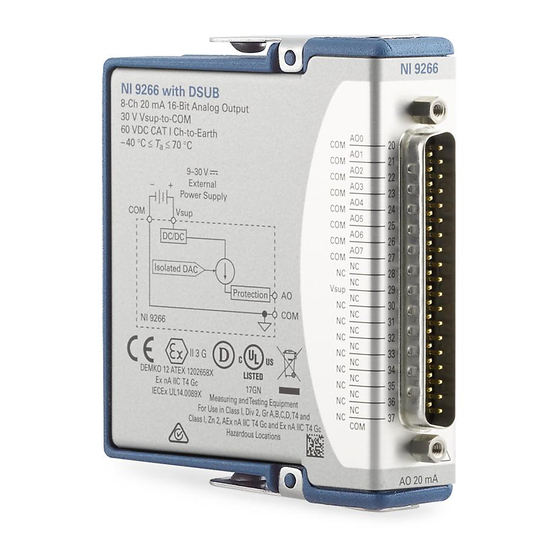Table of Contents
Advertisement
Advertisement
Table of Contents

Summary of Contents for National Instruments 9266
- Page 1 GETTING STARTED GUIDE NI 9266 8 AO, 0 mA to 20 mA, 16 Bit Simultaneous...
-
Page 2: Safety Guidelines
This document explains how to connect to the NI 9266. In this document, the NI 9266 with screw terminal and the NI 9266 with DSUB are referred to inclusively as the NI 9266. Before you begin, complete the software and... -
Page 3: Safety Guidelines For Hazardous Voltages
Do not mix hazardous voltage circuits and Caution human-accessible circuits on the same module. Ensure that devices and circuits connected to Caution the module are properly insulated from human contact. NI 9266 Getting Started Guide | © National Instruments | 3... - Page 4 Withstand up to 3,000 V RMS, verified by a 5 s 3,000 m dielectric withstand test Measurement Category II is for measurements performed on circuits directly connected to the electrical distribution system. 4 | ni.com | NI 9266 Getting Started Guide...
- Page 5 Measurement Categories III or IV. NI 9266 with DSUB Safety Voltages Connect only voltages that are within the following limits. AO-to-COM and ±36 V DC maximum -to-COM Isolation Channel-to-channel None NI 9266 Getting Started Guide | © National Instruments | 5...
- Page 6 Such voltage measurements include signal levels, special equipment, limited-energy parts of equipment, circuits powered by regulated low-voltage sources, and electronics. Do not connect the NI 9266 with DSUB to Caution signals or use for measurements within Measurement Categories II, III, or IV.
-
Page 7: Safety Guidelines For Hazardous Locations
Categories CAT II, CAT III, or CAT IV. Safety Guidelines for Hazardous Locations The NI 9266 is suitable for use in Class I, Division 2, Groups A, B, C, D, T4 hazardous locations; Class I, Zone 2, AEx nA IIC T4 Gc and Ex nA IIC T4 Gc hazardous locations;... -
Page 8: Special Conditions For Hazardous Locations Use In Europe And Internationally
II 3G and is suitable for use in Zone 2 hazardous locations, in ambient temperatures of -40 °C ≤ Ta ≤ 70 °C. If you are using the NI 9266 in Gas Group IIC hazardous locations, you must use the device in an NI chassis that has been evaluated as Ex nC IIC T4, Ex IIC T4, Ex nA IIC T4, or Ex nL IIC T4 equipment. -
Page 9: Electromagnetic Compatibility Guidelines
To minimize interference with radio and television reception and prevent unacceptable performance degradation, install and use this product in strict accordance with the instructions in the product documentation. NI 9266 Getting Started Guide | © National Instruments | 9... -
Page 10: Special Conditions For Marine Applications
In addition, take precautions when designing, selecting, and installing measurement probes and cables to ensure that the desired EMC performance is attained. 10 | ni.com | NI 9266 Getting Started Guide... -
Page 11: Preparing The Environment
Preparing the Environment Ensure that the environment in which you are using the NI 9266 meets the following specifications. Operating temperature -40 °C to 70 °C (IEC 60068-2-1, IEC 60068-2-2) Operating humidity 10% RH to 90% RH, (IEC 60068-2-78) noncondensing... - Page 12 NI 9266 Pinout 12 | ni.com | NI 9266 Getting Started Guide...
- Page 13 Table 1. Signal Descriptions Signal Description Analog output signal connection Common reference connection to isolated ground No connection Voltage supply connection NI 9266 Getting Started Guide | © National Instruments | 13...
- Page 14 Connecting the NI 9266 External Power Supply Power Supply DC/DC Isolated DAC Protection Load Common NI 9266 Mode Voltage 14 | ni.com | NI 9266 Getting Started Guide...
-
Page 15: Connecting An External Power Supply
Connecting an External Power Supply You must connect an external power supply with a 9 V DC to 30 V DC voltage range to the NI 9266. This power supply provides the current for the devices you connect to the module. -
Page 16: High-Vibration Application Connections
Use ferrules to terminate wires to the detachable connector. • Use the NI 9928 connector backshell kit. Overvoltage Protection The NI 9266 provides overvoltage protection for each channel. Refer to the device datasheet on ni.com/manuals Note for more information about overvoltage protection. -
Page 17: Where To Go Next
NI 9266 Datasheet NI-RIO Help NI-DAQmx Help LabVIEW FPGA Help LabVIEW Help RELATED INFORMATION C Series Documentation Services & Resources ni.com/services ni.com/info cseriesdoc Located at ni.com/manuals Installs with the software NI 9266 Getting Started Guide | © National Instruments | 17... -
Page 18: Worldwide Support And Services
(EMC) and product safety. You can obtain the DoC for your product by visiting ni.com/certification. If your product supports calibration, you can obtain the calibration certificate for your product at ni.com/calibration. 18 | ni.com | NI 9266 Getting Started Guide... - Page 19 United States, visit the Worldwide Offices section of ni.com/niglobal to access the branch office websites, which provide up-to-date contact information, support phone numbers, email addresses, and current events. NI 9266 Getting Started Guide | © National Instruments | 19...
- Page 20 For patents covering NI products/technology, refer to the appropriate location: Help»Patents in your software, file on your media, or the National Instruments Patent Notice at patents.txt ni.com/ . You can find information about end-user license agreements (EULAs) and third-party patents legal notices in the readme file for your NI product.












Need help?
Do you have a question about the 9266 and is the answer not in the manual?
Questions and answers